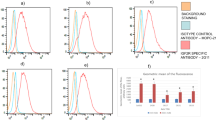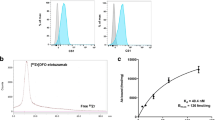Abstract
Purpose
Osteosarcoma (OS) is the most frequently diagnosed bone cancer in children with little improvement in overall survival in the past decades. The high surface expression of disialoganglioside GD2 on OS tumors and restricted expression in normal tissues makes it an ideal target for anti-OS radiopharmaceuticals. Since human and canine OS share many biological and molecular features, spontaneously occurring OS in canines has been an ideal model for testing new imaging and treatment modalities for human translation. In this study, we evaluated a humanized anti-GD2 antibody, hu3F8, as a potential delivery vector for targeted radiopharmaceutical imaging of human and canine OS.
Methods
The cross-reactivity of hu3F8 with human and canine OS cells and tumors was examined by immunohistochemistry and flow cytometry. The hu3F8 was radiolabeled with indium-111, and the biodistribution of [111In]In-hu3F8 was assessed in tumor xenograft-bearing mice. The targeting ability of [111In]In-hu3F8 to metastatic OS was tested in spontaneous OS canines.
Results
The hu3F8 cross reacts with human and canine OS cells and canine OS tumors with high binding affinity. Biodistribution studies revealed selective uptake of [111In]In-hu3F8 in tumor tissue. SPECT/CT imaging of spontaneous OS canines demonstrated avid uptake of [111In]In-hu3F8 in all metastatic lesions. Immunohistochemistry confirmed the extensive binding of radiolabeled hu3F8 within both osseous and soft lesions.
Conclusion
This study demonstrates the feasibility of targeting GD2 on OS cells and spontaneous OS canine tumors using hu3F8-based radiopharmaceutical imaging. Its ability to deliver an imaging payload in a targeted manner supports the utility of hu3F8 for precision imaging of OS and potential future use in radiopharmaceutical therapy.







Similar content being viewed by others
Data availability
All data associated with this study are present in the paper or the Supplementary Materials.
References
Roberts RD, Lizardo MM, Reed DR, Hingorani P, Glover J, Allen-Rhoades W, et al. Provocative questions in osteosarcoma basic and translational biology: a report from the Children’s Oncology Group. Cancer. 2019;125:3514–25. https://doi.org/10.1002/cncr.32351.
Sampson VB, Gorlick R, Kamara D, Anders KE. A review of targeted therapies evaluated by the pediatric preclinical testing program for osteosarcoma. Front Oncol. 2013;3:132. https://doi.org/10.3389/fonc.2013.00132.
Gorlick R, Janeway K, Lessnick S, Randall RL, Marina N. Children’s Oncology Group’s 2013 blueprint for research: bone tumors. Pediatr Blood Cancer. 2013;60:1009–15. https://doi.org/10.1002/pbc.24429.
Kansara M, Teng MW, Smyth MJ, Thomas DM. Translational biology of osteosarcoma. Nat Rev Cancer. 2014;14:722–35. https://doi.org/10.1038/nrc3838.
Heiner JP, Miraldi F, Kallick S, Makley J, Neely J, Smith-Mensah WH, et al. Localization of GD2-specific monoclonal antibody 3F8 in human osteosarcoma. Cancer Res. 1987;47:5377–81.
Poon VI, Roth M, Piperdi S, Geller D, Gill J, Rudzinski ER, et al. Ganglioside GD2 expression is maintained upon recurrence in patients with osteosarcoma. Clin Sarcoma Res. 2015;5:4. https://doi.org/10.1186/s13569-014-0020-9.
Nazha B, Inal C, Owonikoko TK. Disialoganglioside GD2 expression in solid tumors and role as a target for cancer therapy. Front Oncol. 2020;10:1000. https://doi.org/10.3389/fonc.2020.01000.
Modak S, Le Luduec JB, Cheung IY, Goldman DA, Ostrovnaya I, Doubrovina E, et al. Adoptive immunotherapy with haploidentical natural killer cells and Anti-GD2 monoclonal antibody m3F8 for resistant neuroblastoma: results of a phase I study. Oncoimmunology. 2018;7: e1461305. https://doi.org/10.1080/2162402x.2018.1461305.
Butch ER, Mead PE, Amador Diaz V, Tillman H, Stewart E, Mishra JK, et al. Positron emission tomography detects in vivo expression of disialoganglioside GD2 in mouse models of primary and metastatic osteosarcoma. Cancer Res. 2019;79:3112–24. https://doi.org/10.1158/0008-5472.Can-18-3340.
Roth M, Linkowski M, Tarim J, Piperdi S, Sowers R, Geller D, et al. Ganglioside GD2 as a therapeutic target for antibody-mediated therapy in patients with osteosarcoma. Cancer. 2014;120:548–54. https://doi.org/10.1002/cncr.28461.
Dobrenkov K, Cheung NK. GD2-targeted immunotherapy and radioimmunotherapy. Semin Oncol. 2014;41:589–612. https://doi.org/10.1053/j.seminoncol.2014.07.003.
Cheung NK, Cheung IY, Kushner BH, Ostrovnaya I, Chamberlain E, Kramer K, et al. Murine anti-GD2 monoclonal antibody 3F8 combined with granulocyte-macrophage colony-stimulating factor and 13-cis-retinoic acid in high-risk patients with stage 4 neuroblastoma in first remission. J Clin Oncol. 2012;30:3264–70. https://doi.org/10.1200/jco.2011.41.3807.
Cheung NK, Guo H, Hu J, Tassev DV, Cheung IY. Humanizing murine IgG3 anti-GD2 antibody m3F8 substantially improves antibody-dependent cell-mediated cytotoxicity while retaining targeting in vivo. Oncoimmunology. 2012;1:477–86.
Markham A. Naxitamab: first approval. Drugs. 2021;81:291–6. https://doi.org/10.1007/s40265-021-01467-4.
Fenger JM, London CA, Kisseberth WC. Canine osteosarcoma: a naturally occurring disease to inform pediatric oncology. ILAR J. 2014;55:69–85. https://doi.org/10.1093/ilar/ilu009.
MacEwen EG. Spontaneous tumors in dogs and cats: models for the study of cancer biology and treatment. Cancer Metastasis Rev. 1990;9:125–36.
Karkare S, Allen KJH, Jiao R, Malo ME, Dawicki W, Helal M, et al. Detection and targeting insulin growth factor receptor type 2 (IGF2R) in osteosarcoma PDX in mouse models and in canine osteosarcoma tumors. Sci Rep. 2019;9:11476. https://doi.org/10.1038/s41598-019-47808-y.
Westrøm S, Bønsdorff TB, Abbas N, Bruland ØS, Jonasdottir TJ, Mælandsmo GM, et al. Evaluation of CD146 as target for radioimmunotherapy against osteosarcoma. PLoS ONE. 2016;11: e0165382. https://doi.org/10.1371/journal.pone.0165382.
Sgouros G, Bodei L, McDevitt MR, Nedrow JR. Radiopharmaceutical therapy in cancer: clinical advances and challenges. Nat Rev Drug Discov. 2020;19:589–608. https://doi.org/10.1038/s41573-020-0073-9.
Miederer M, McDevitt MR, Borchardt P, Bergman I, Kramer K, Cheung NK, et al. Treatment of neuroblastoma meningeal carcinomatosis with intrathecal application of alpha-emitting atomic nanogenerators targeting disialo-ganglioside GD2. Clin Cancer Res. 2004;10:6985–92. https://doi.org/10.1158/1078-0432.CCR-04-0859.
Senthamizhchelvan S, Hobbs RF, Song H, Frey EC, Zhang Z, Armour E, et al. Tumor dosimetry and response for 153Sm-ethylenediamine tetramethylene phosphonic acid therapy of high-risk osteosarcoma. J Nucl Med. 2012;53:215–24. https://doi.org/10.2967/jnumed.111.096677.
Brechbiel MW. Bifunctional chelates for metal nuclides. Q J Nucl Med Mol Imaging. 2008;52:166–73.
Nedrow JR, Josefsson A, Park S, Ranka S, Roy S, Sgouros G. Imaging of programmed cell death ligand 1: impact of protein concentration on distribution of anti-PD-L1 SPECT agents in an immunocompetent murine model of melanoma. J Nucl Med. 2017;58:1560–6. https://doi.org/10.2967/jnumed.117.193268.
Cortez A, Josefsson A, McCarty G, Shtekler AE, Rao A, Austin Z, et al. Evaluation of [(225)Ac]Ac-DOTA-anti-VLA-4 for targeted alpha therapy of metastatic melanoma. Nucl Med Biol. 2020;88–89:62–72. https://doi.org/10.1016/j.nucmedbio.2020.07.006.
Dobrenkov K, Ostrovnaya I, Gu J, Cheung IY, Cheung NK. Oncotargets GD2 and GD3 are highly expressed in sarcomas of children, adolescents, and young adults. Pediatr Blood Cancer. 2016;63:1780–5. https://doi.org/10.1002/pbc.26097.
Harrison DJ, Geller DS, Gill JD, Lewis VO, Gorlick R. Current and future therapeutic approaches for osteosarcoma. Expert Rev Anticancer Ther. 2018;18:39–50. https://doi.org/10.1080/14737140.2018.1413939.
Beaino W, Nedrow JR, Anderson CJ. Evaluation of (68)Ga- and (177)Lu-DOTA-PEG4-LLP2A for VLA-4-targeted PET imaging and treatment of metastatic melanoma. Mol Pharm. 2015;12:1929–38. https://doi.org/10.1021/mp5006917[doi].
Geller DS, Morris J, Revskaya E, Kahn M, Zhang W, Piperdi S, et al. Targeted therapy of osteosarcoma with radiolabeled monoclonal antibody to an insulin-like growth factor-2 receptor (IGF2R). Nucl Med Biol. 2016;43:812–7. https://doi.org/10.1016/j.nucmedbio.2016.07.008.
Li HK, Hasegawa S, Nakajima NI, Morokoshi Y, Minegishi K, Nagatsu K. Targeted cancer cell ablation in mice by an α-particle-emitting astatine-211-labeled antibody against major histocompatibility complex class I chain-related protein A and B. Biochem Biophys Res Commun. 2018;506:1078–84. https://doi.org/10.1016/j.bbrc.2018.10.157.
Park JS, Withers SS, Modiano JF, Kent MS, Chen M, Luna JI, et al. Canine cancer immunotherapy studies: linking mouse and human. J Immunother Cancer. 2016;4:97. https://doi.org/10.1186/s40425-016-0200-7.
Magee K, Marsh IR, Turek MM, Grudzinski J, Aluicio-Sarduy E, Engle JW, et al. Safety and feasibility of an in situ vaccination and immunomodulatory targeted radionuclide combination immuno-radiotherapy approach in a comparative (companion dog) setting. PLoS ONE. 2021;16: e0255798. https://doi.org/10.1371/journal.pone.0255798.
Broqueza J, Prabaharan CB, Andrahennadi S, Allen KJH, Dickinson R, MacDonald-Dickinson V, et al. Novel human antibodies to insulin growth factor 2 receptor (IGF2R) for radioimmunoimaging and therapy of canine and human osteosarcoma. Cancers (Basel). 2021;13. doi:https://doi.org/10.3390/cancers13092208.
Broqueza J, Prabaharan CB, Allen KJH, Jiao R, Fisher DR, Dickinson R, et al. Radioimmunotherapy targeting IGF2R on canine-patient-derived osteosarcoma tumors in mice and radiation dosimetry in canine and pediatric models. Pharmaceuticals (Basel). 2021;15. doi:https://doi.org/10.3390/ph15010010.
F Navid PM Sondel R Barfield BL Shulkin RA Kaufman JA Allay et al 2014 Phase I trial of a novel anti-GD2 monoclonal antibody Hu14.18K322A designed to decrease toxicity in children with refractory or recurrent neuroblastoma J Clin Oncol. 32 1445 52 https://doi.org/10.1200/jco.2013.50.4423
Funding
This work was supported by the National Institutes Health grants: R01 CA116477, R01 CA187037, and R01 CA239124.
Author information
Authors and Affiliations
Contributions
Y. F., J. Y., and I. L. designed and performed all the murine experiments and collected and analyzed the data. Y. F. and J. Y. wrote the original manuscript, and all authors reviewed and edited the manuscript.
Y. D., A. J., and J. N. collected, analyzed, and interpreted data from SPECT/CT images.
H. R. and J. B. collected and analyzed flow cytometry data.
D. L. K. and G. S. acquired funding, directed the research, and supervised in the design and interpretation of the experiments and the writing of the manuscript.
D. L. K. performed all the canine experiments.
Corresponding author
Ethics declarations
Ethics approval and consent to participate
Animal protocols were approved by the Animal Care and Use Committee of the Johns Hopkins University, School of Medicine. Client-owned dogs with confirmed metastatic OS were recruited from owners with written informed consent.
Conflict of interest
The authors report no relevant conflicts of interest.
Additional information
Publisher's note
Springer Nature remains neutral with regard to jurisdictional claims in published maps and institutional affiliations.
This article is part of the Topical Collection on Translational research.
Supplementary Information
Below is the link to the electronic supplementary material.
Rights and permissions
About this article
Cite this article
Fu, Y., Yu, J., Liatsou, I. et al. Anti-GD2 antibody for radiopharmaceutical imaging of osteosarcoma. Eur J Nucl Med Mol Imaging 49, 4382–4393 (2022). https://doi.org/10.1007/s00259-022-05888-5
Received:
Accepted:
Published:
Issue Date:
DOI: https://doi.org/10.1007/s00259-022-05888-5




